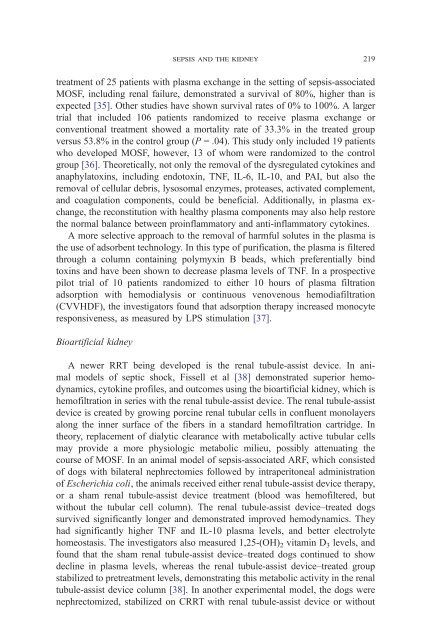sepsis and the kidney.pdf - SASSiT
sepsis and the kidney.pdf - SASSiT
sepsis and the kidney.pdf - SASSiT
You also want an ePaper? Increase the reach of your titles
YUMPU automatically turns print PDFs into web optimized ePapers that Google loves.
treatment of 25 patients with plasma exchange in <strong>the</strong> setting of <strong>sepsis</strong>-associated<br />
MOSF, including renal failure, demonstrated a survival of 80%, higher than is<br />
expected [35]. O<strong>the</strong>r studies have shown survival rates of 0% to 100%. A larger<br />
trial that included 106 patients r<strong>and</strong>omized to receive plasma exchange or<br />
conventional treatment showed a mortality rate of 33.3% in <strong>the</strong> treated group<br />
versus 53.8% in <strong>the</strong> control group (P = .04). This study only included 19 patients<br />
who developed MOSF, however, 13 of whom were r<strong>and</strong>omized to <strong>the</strong> control<br />
group [36]. Theoretically, not only <strong>the</strong> removal of <strong>the</strong> dysregulated cytokines <strong>and</strong><br />
anaphylatoxins, including endotoxin, TNF, IL-6, IL-10, <strong>and</strong> PAI, but also <strong>the</strong><br />
removal of cellular debris, lysosomal enzymes, proteases, activated complement,<br />
<strong>and</strong> coagulation components, could be beneficial. Additionally, in plasma exchange,<br />
<strong>the</strong> reconstitution with healthy plasma components may also help restore<br />
<strong>the</strong> normal balance between proinflammatory <strong>and</strong> anti-inflammatory cytokines.<br />
A more selective approach to <strong>the</strong> removal of harmful solutes in <strong>the</strong> plasma is<br />
<strong>the</strong> use of adsorbent technology. In this type of purification, <strong>the</strong> plasma is filtered<br />
through a column containing polymyxin B beads, which preferentially bind<br />
toxins <strong>and</strong> have been shown to decrease plasma levels of TNF. In a prospective<br />
pilot trial of 10 patients r<strong>and</strong>omized to ei<strong>the</strong>r 10 hours of plasma filtration<br />
adsorption with hemodialysis or continuous venovenous hemodiafiltration<br />
(CVVHDF), <strong>the</strong> investigators found that adsorption <strong>the</strong>rapy increased monocyte<br />
responsiveness, as measured by LPS stimulation [37].<br />
Bioartificial <strong>kidney</strong><br />
<strong>sepsis</strong> <strong>and</strong> <strong>the</strong> <strong>kidney</strong> 219<br />
A newer RRT being developed is <strong>the</strong> renal tubule-assist device. In animal<br />
models of septic shock, Fissell et al [38] demonstrated superior hemodynamics,<br />
cytokine profiles, <strong>and</strong> outcomes using <strong>the</strong> bioartificial <strong>kidney</strong>, which is<br />
hemofiltration in series with <strong>the</strong> renal tubule-assist device. The renal tubule-assist<br />
device is created by growing porcine renal tubular cells in confluent monolayers<br />
along <strong>the</strong> inner surface of <strong>the</strong> fibers in a st<strong>and</strong>ard hemofiltration cartridge. In<br />
<strong>the</strong>ory, replacement of dialytic clearance with metabolically active tubular cells<br />
may provide a more physiologic metabolic milieu, possibly attenuating <strong>the</strong><br />
course of MOSF. In an animal model of <strong>sepsis</strong>-associated ARF, which consisted<br />
of dogs with bilateral nephrectomies followed by intraperitoneal administration<br />
of Escherichia coli, <strong>the</strong> animals received ei<strong>the</strong>r renal tubule-assist device <strong>the</strong>rapy,<br />
or a sham renal tubule-assist device treatment (blood was hemofiltered, but<br />
without <strong>the</strong> tubular cell column). The renal tubule-assist device–treated dogs<br />
survived significantly longer <strong>and</strong> demonstrated improved hemodynamics. They<br />
had significantly higher TNF <strong>and</strong> IL-10 plasma levels, <strong>and</strong> better electrolyte<br />
homeostasis. The investigators also measured 1,25-(OH) 2 vitamin D 3 levels, <strong>and</strong><br />
found that <strong>the</strong> sham renal tubule-assist device–treated dogs continued to show<br />
decline in plasma levels, whereas <strong>the</strong> renal tubule-assist device–treated group<br />
stabilized to pretreatment levels, demonstrating this metabolic activity in <strong>the</strong> renal<br />
tubule-assist device column [38]. In ano<strong>the</strong>r experimental model, <strong>the</strong> dogs were<br />
nephrectomized, stabilized on CRRT with renal tubule-assist device or without
















